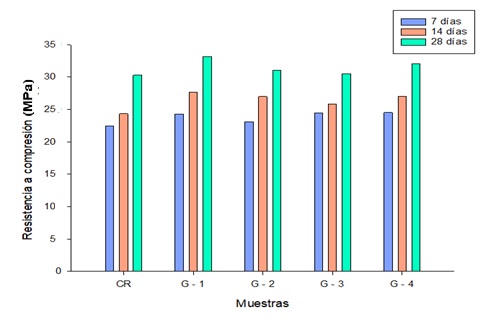Optimization of the mechanical properties of rigid pavement concrete using coca leaves and steel fibers
DOI:
https://doi.org/10.51372/gacetatecnica261.6Keywords:
concrete mechanical properties, pavement, concrete compressive strength, concrete flexural strengthAbstract
The objective of the study presented here is to optimize the mechanical support characteristics of resistant concrete used in road structures by applying coca leaf ash and steel fiber additives. Therefore, 45 specimens were used for compression resistance, another 45 as beams evaluated in bending, as well as 15 for settlement, in accordance with the provisions of standard E.0.60. On the twenty-eighth day, a maximum stress of 35,53 MPa in compression was achieved for the design made up of 1,75% coca leaf ash and 1,75% steel fibers, while in flexural strength a stress maximum of 5,24 MPa for design 2 made up of steel fibers and 2,50% coca leaf ash, the slump of design 1 made up of 1,75 of steel fiber and coca leaf ashes acquired a slump of 2,83”. The application of this mixture effectively contributes in a different magnitude to the properties evaluated in this study
Downloads
References
M. Becerra, “Estado del arte de diseño y construcción de pavimentos de concreto” CONSULCRETO, Disponible en: https://consultcreto.com/wp-content/uploads/2024/12/ESTADO-DEL-ARTE-DE-DISENO-Y-CONSTRUCCION-DE-PAVIMENTOS-DE-CONCRETO.pdf, Lima, Perú, 2019
J. U. D. Hatmoko y L. Lendra, “How sustainable are flexible and rigid pavement? A Life Cycle Impact Assessment (LCIA) approach”, IOP Conf. Ser.: Mater. Sci. Eng., vol. 1072, nº 1, p. 1-12, 2021
Y. W. Yung-Vargas, H. A. Rondón-Quintana y J. E. Córdoba-Maquilón, “Evaluation of recycled asphalt pavement in Colombia”, J. Phys.: Conf. Ser., vol. 2153, nº 1, p. 1-5, 2022
S. A. De La Cruz Vega, C. E. Ibañez Ccoapaza y D. Y. Coaquira Cueva, “Determinación de índice de serviciabilidad y capacidad resistente. caso práctico: Pavimentos en Azángaro, Puno, Perú”, Infraestruct. Vial, vol. 24, nº 43, pp. 1–8, 2022
S. A. De La Cruz Vega y G. A. Paredes Cahuana, “Diseño de infraestructura vial con pavimento flexible para mejora de transitabilidad de la avenida Industrial, Lurín, Lima”, Mem. Investig. En Ing., n° 21, pp. 108-114, 2021
R. Reyna Salazar, C. J. Santos Acco y C. A. Acuña Asenjo, “Estudio experimental de las propiedades mecánicas del hormigón simple y reforzado con fibras bajo carga monotónica”, Tecnia, vol. 32, nº 2, 2022
I. U. Khan, A. Gul, K. Khan, S. Akbar y Irfanullah, “Mechanical properties of steel-fiber-reinforced concrete”, Icec 2022. Basel Switzerland: MDPI, 2022
P. Murthi, K. Poongodi y R. Gobinath, “Correlation between rebound hammer number and mechanical properties of steel fibre reinforced pavement quality concrete”, Mater. Today: Proc., vol. 39, n° 1, pp. 142-147, 2021
A. Hassan, S. Galal, A. Hassan y A. Salman, “Utilization of carbon nanotubes and steel fibers to improve the mechanical properties of concrete pavement”, Beni-Suef Univ. J. Basic Appl. Sci., vol. 11, nº 1, 2022
L. H. P. Silva et al., “Bamboo leaf ash for use as mineral addition with Portland cement”, J. Building Eng., vol. 42, pp. 102769, 2021
F. C. Marlón et al., “Fibras de acero en la resistencia a la compresión del concreto”, Gaceta Técnica., vol. 20, n° 2, pp. 4-13, 2019
P. D. Juarez Viera, E. G. Sanchez Zapata y S. De la Cruz Vega, “Use of recycled steel fibers to improve the structural behavior of rigid pavement”, Univ. Cienc. Tecnol., vol. 27, n.º 120, pp. 8–18, 2023
D.-W. Song, “What is research?”, WMU J. Maritime Affairs, vol. 20, nº 4, pp. 407–411, 2021
R. Pratama, et al., “Correlational research”, JIIP - J. Ilm. Ilmu Pendidik., vol. 6, nº 3, pp. 1754–1759, 2023
F. A. Sánchez Flores, “Fundamentos epistémicos de la investigación cualitativa y cuantitativa: Consensos y disensos”, Revista Digit. de Investigación en Docencia Universitaria, pp. 101–122, 2019
Ministerio de Vivienda, Construcción y Saneamiento, “Norma E.060 Concreto Armado” CENCICO, Lima, Perú, 2019
ASTM A820, “Standard Specification for Steel Fibers for Fiber-Reinforced Concrete”, ASTM International, EUA, 2022
ASTM E11-24, “Standard Specification for Woven Wire Test Sieve Cloth and Test Sieves”, ASTM International, EUA, 2024
Norma Técnica NTP 400.037, “AGREGADOS. Especificaciones normalizadas para agregados en concreto”, INACAL, Perú, 2014
S. Jorge, A. Byron y B. César, “Influencia de la calidad de los agregados y tipo de cemento en la resistencia a la compresión del hormigón dosificado al volumen”, NOVASINERGIA, vol. 4, n° 1, pp. 91-101, 2021

Published
How to Cite
Issue
Section

This work is licensed under a Creative Commons Attribution-NonCommercial-ShareAlike 4.0 International License.
The opinions expressed by the authors do not necessarily reflect the position of the editor of the publication or UCLA. The total or partial reproduction of the texts published here is authorized, provided that the complete source and electronic address of this journal is cited. Authors have the right to use their articles for any purpose as long as it is done nonprofit. The authors can post on the internet or any other media the final approved version of their work.






.png)




